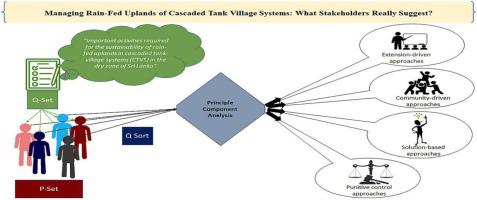Agricultural Systems ( IF 6.6 ) Pub Date : 2023-03-30 , DOI: 10.1016/j.agsy.2023.103643 S.M.C.B. Karalliyadda , Tsuji Kazunari , Miho Fujimura

|
CONTEXT
Achieving land degradation neutrality through sustainable land management requires stakeholder collaboration. Understanding of stakeholders' worldviews facilitates fostering stakeholder collaboration. Reported lack of stakeholder collaboration in CTVS-related conservation and development programs may be due to stakeholders' competing worldviews and marginalizing primary stakeholders' viewpoints.
OBJECTIVE
This study systematically investigates stakeholders' worldviews on sustainable management of the rain-fed uplands of CTVS.
METHODS
The Q-Methodology was used with a Q set of 54 land management activities. Twenty-seven respondents with different expertise were given a forced-choice distribution grid (Q-sorts): an 11-point scale (ranging from −5 = least important I think to +5 most important I think) to rank the Q-Set. Using the principal component analysis with varimax rotation in Ken-Q Analysis Desktop Edition Q sorts were analyzed.
RESULTS AND CONCLUSIONS
Stakeholders' worldviews towards sustainable rain-fed uplands are four-fold (extension-driven approaches, community-driven approaches, solution-based approaches and punitive control approaches), based on power and facilitation and irrespective of their social backgrounds. Many worldviews do not compete and can facilitate stakeholder collaboration, whereas the worldview that relies on coercion to achieve conservation behavior may be a potential bottleneck for stakeholder reconciliation.
SIGNIFICANCE
This study has demonstrated how useful it is to utilize a systematic investigation to understand stakeholders' worldviews towards conservation solutions. As a result, it facilitates exploring challenges and opportunities by policymakers to facilitate cooperation between stakeholders while avoiding bottlenecks to achieve sustainable management of rain-fed uplands in CTVS.
中文翻译:

管理级联坦克村系统的雨水灌溉高地:利益相关者的真正建议是什么?
语境
通过可持续的土地管理实现土地退化零增长需要利益相关者的合作。了解利益相关者的世界观有助于促进利益相关者的协作。据报道,在与 CTVS 相关的保护和发展计划中利益相关者缺乏合作,这可能是由于利益相关者的竞争世界观和边缘化主要利益相关者的观点。
客观的
本研究系统地调查了利益相关者对 CTVS 雨养高地可持续管理的世界观。
方法
Q 方法用于 Q 集的 54 项土地管理活动。给具有不同专业知识的 27 名受访者提供了一个强制选择分布网格(Q 排序):一个 11 分制的量表(从 −5 = 我认为最不重要到 +5 我认为最重要)对 Q 集进行排名. 在 Ken-Q 分析桌面版中使用方差最大旋转的主成分分析对 Q 排序进行了分析。
结果和结论
利益相关者对可持续雨养高地的世界观有四重(扩展驱动方法、社区驱动方法、基于解决方案的方法和惩罚性控制方法),基于权力和促进,而不考虑他们的社会背景。许多世界观不相互竞争,可以促进利益相关者的合作,而依赖强制实现保护行为的世界观可能是利益相关者和解的潜在瓶颈。
意义
这项研究证明了利用系统调查来了解利益相关者对保护解决方案的世界观是多么有用。因此,它有助于决策者探索挑战和机遇,以促进利益相关者之间的合作,同时避免瓶颈,以实现 CTVS 中雨养高地的可持续管理。



























 京公网安备 11010802027423号
京公网安备 11010802027423号